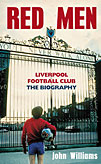 Liverpool Football Club – The Biography
Liverpool Football Club – The Biography
by John Williams
Mainstream, £16.99
Reviewed by Seb Patrick
From WSC 284 October 2010
There's an inherent problem in writing a "biography" of a football club. The term can suitably be applied to people, who have a finite lifespan of anything up to 80 or 90 years – but when it comes to top-level clubs, the fact that they can reasonably be expected to outlive the author means that it's impossible ever to write a complete one.
So it is with John Williams's Red Men, which although a comprehensive record of the club's existence at the moment he stopped typing (which seems to have been a week or so after Roy Hodgson's appointment), is already increasingly incomplete with each day that goes by, and will only continue to be so.
The exercise begins to look particularly futile once it becomes apparent that a thorough examination of all 120 years may not have been Williams's original intent. It's clear merely from skimming through the distribution of the chapter headings – more than two-thirds of the book passing before Bill Shankly turns up – that his real interest is in the first half of the 20th century. And it's this section of the book that succeeds the most.
A generally underexplored stretch of the club's history, Williams attacks the periods leading up to and between the wars with gusto. Of course, he can't rely on eyewitness accounts or his own experiences – but with meticulously researched material from newspapers and other contemporary publications, and a desire to continually place the club's development within the socio-economic context of the city, it makes for an often compelling read. There are good vignettes here and there, such as the tale of the 1914 FA Cup final and the unique charity "replay" that took place back in Liverpool afterwards.
For this latter third of the book, things often feel rather perfunctory. While the best biographies are often thematic rather than simply chronological, Williams finds little to unite his subjects, instead simply reeling through the facts in a style that rarely deviates. There are brief digressions that muse on Shankly's reasons for leaving, or the author's opinions on Hillsborough, or the characters of Stan Collymore and Robbie Fowler – but the majority of the book consists of little other than rote accounts of who was playing for the club at a particular time, and what they achieved. At times here, even the book's claim to be comprehensive suffers, as whole seasons are dismissed in barely a paragraph. During the 1990s this attitude is almost understandable – but the entire 1970s are dealt with in around 30 pages.
One suspects that had Williams been able to write the book he clearly wanted to, focusing squarely on those early few decades, there'd be a lot more of his heart and character in it. As it is, although it makes an admirable stab at giving an overview of the club's entire history, in places it struggles to convince as a page-turner.